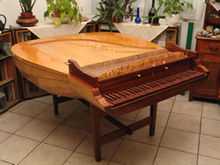Lautenwerck

Lautenwerck type
The lautenwerck (also spelled lautenwerk), or lute-harpsichord (lute-clavier), was a European keyboard instrument of the Baroque period. It was similar to a harpsichord, but with gut rather than metal strings, producing a mellow tone.
The instrument was favored by J. S. Bach, who owned two of the instruments at the time of his death, but no specimens from the 18th century have survived to the present day.[1] It was revived in the 20th century by harpsichord makers Willard Martin, Keith Hill and Steven Sorli. Two of its most prominent performers are the early music specialists Gergely Sárközy and Robert Hill.
Media
Performances by Martha Goldstein:
- BWV 997 - Prelude
- BWV 997 - Fuge
- BWV 997 - Sarabande
- BWV 997 - Gigue
- BWV 998 - Prelude
- BWV 998 - Fuge
- BWV 998 - Allegro
- BWV 996 - Prelude-Presto
- BWV 996 - Allemande
- BWV 996 - Courante
- BWV 996 - Sarabande
- BWV 996 - Bourre
- BWV 996 - Gigue
Performances by Felix Skowronek (flute) with Martha Goldstein:
- Flute Sonata in B minor BWV 1030 - 1. Andante
- Flute Sonata in B minor BWV 1030 - 2. Largo e Dolce
- Flute Sonata in B minor BWV 1030 - 3. Presto
Performances by Gergely Sárközy:
Notes
- ↑ Henning, p. 477
References
- Henning, Uta (October 1982). "The Most Beautiful Among the Claviers: Rudolf Richter's Reconstruction of a Baroque Lute-Harpsichord". Early Music (Volume 10, No. 4). JSTOR 3126936.
External links
- Lautenwerck page
- Information (Tihamér Romanek)
- Gallery of pictures and sounds (Stevie Sorli)